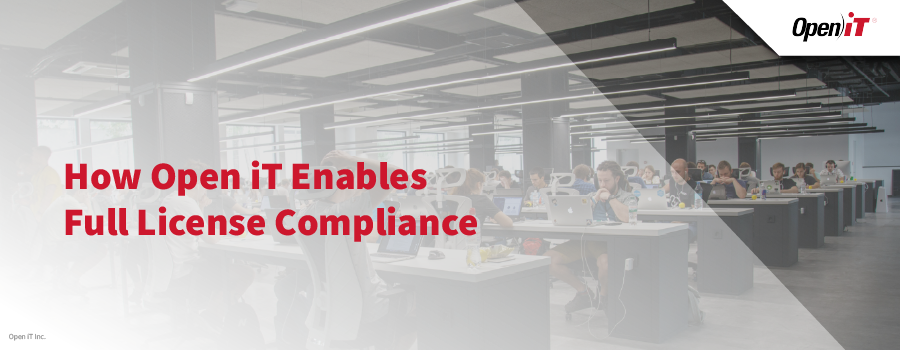For automotive OEMs, software license compliance is a non-negotiable contractual and operational imperative.
CATIA powers mission-critical design and simulation processes in the automotive industry. But with complex licensing models and decentralized engineering environments, software license compliance becomes a major challenge for automotive OEMs. Missteps can result in vendor audits, unplanned true-ups, and millions in penalties.
Open iT empowers OEMs to prevent these negative outcomes. By providing complete transparency and granular control over CATIA license usage, Open iT transforms compliance from a liability into an operational advantage, reducing risk while boosting efficiency.
4 High Stakes Challenges of Software License Compliance
For automotive OEMs, software license compliance is a non-negotiable contractual and operational imperative. The nature of CATIA licensing introduces specific, high-stakes challenges:
- Complex Agreements: A mix of concurrent, named-user, and token-based licenses obscures true license position and exposure.
- Uncontrolled Access: High-cost modules can be launched without entitlement, often unintentionally, creating immediate non-compliance.
- Global Disparities: Engineering teams across different geographies have unique usage patterns and varying levels of compliance discipline.
- Fragmented Data: License data is often siloed, outdated, or incomplete, making proactive governance nearly impossible.
Each of these vulnerabilities significantly increases the likelihood of a non-compliance event. If left unaddressed, they can trigger disruptive vendor audits, halt engineering productivity, and result in severe financial penalties. Proactive monitoring is the only way to identify and neutralize these risks before they escalate.
5 Common CATIA License Compliance Risks for OEMs
Our work with leading global automotive OEMs reveals five common patterns of CATIA non-compliance:
1. Unlicensed Access
Engineers access high-value add-on modules for which they are not licensed. This often stems from poor configuration control or a lack of governance and immediately exposes the OEM to audit findings.
2. Concurrent Overuse
During peak hours, floating licenses exceed their limits—triggering vendor scrutiny and increasing compliance audit exposure.
3. Idle License Consumption
Engineers check out expensive licenses but leave them inactive for hours or days. This not only inflates perceived demand but also wastes budget by hiding gross operational inefficiencies.
4. Named User Violations
Named-user licenses remain assigned to former employees, duplicate accounts, or service logins, directly violating vendor agreements and creating unnecessary costs.
5. Fragmented Oversight
Each engineering site or business unit manages its own licenses, leading to inconsistent policies, siloed data, and no enterprise-wide view of compliance or spending.
These risks are not hypothetical. Vendors increasingly rely on usage data to initiate license audits and enforce compliance. OEMs need a better way to track, manage, and validate their CATIA license usage through continuous compliance monitoring.
Five (5) Ways How Open iT Enables Full License Compliance

Open iT delivers software license compliance through data, automation, and control. Here’s how automotive OEMs use Open iT to eliminate CATIA compliance risks:
1. Granular Usage Tracking
Open iT captures detailed session-level usage data. Each time a CATIA license is checked out—whether for a core product or a specialized add-on module—the system logs:
- User identity: Who used the license?
- Module detail: Which specific CATIA module or feature was accessed?
- Duration: How long the license was held?
- Activity level: Whether the session was actively used or idle?
- Location: Where the session originated (workstation, site, region)?
This depth of visibility allows OEMs to map actual usage against entitlements in real time and retrospectively. License overuse, unauthorized access, and idle licenses can be spotted immediately, reducing the risk of accidental non-compliance and waste.
Relevant Product: LicenseAnalyzer offers deep usage metering and reporting across applications.
2. Automated Compliance Enforcement
Manual compliance monitoring is slow, error-prone, and hard to scale. Open iT enables automated policy enforcement to ensure continuous license compliance across global teams. Organizations can:
- Detect and reclaim idle licenses automatically after configurable inactivity thresholds
- Restrict access to premium or high-cost CATIA modules based on user roles or project needs
- Set and enforce concurrency caps, preventing oversubscription of limited licenses
- Trigger alerts when usage approaches or exceeds defined limits
These automated controls eliminate reliance on manual license management, reduce non-compliance incidents, and protect OEMs from avoidable penalties and software denials.
3. Centralized License Governance
For multi-site, multinational automotive OEMs, decentralized license management is a compliance risk. Open iT provides centralized governance by consolidating license data across all business units and geographies in a unified dashboard. This allows organizations to:
- Apply standardized compliance policies globally
- Provide shared dashboards and reporting tools to local teams and IT admins
- Enable cross-site visibility for better coordination and resource planning
- Simplify license allocation and optimization across the enterprise
This centralized model ensures that every site follows the same rules, sees the same data, and has the same ability to respond to license usage challenges—reducing the chance of inconsistent practices that could trigger a license audit.
Relevant Product: CLIMS (Centralized License Integration and Management System) allows real-time, centralized control of license servers and files.
4. Vendor Audit Preparedness
Open iT reduces the stress and exposure of software vendor audits by giving OEMs instant access to comprehensive historical usage logs. License administrators can:
- Quickly export reports that align with Dassault Systèmes’ audit requirements
- Show clear evidence of entitlement matching actual usage
- Demonstrate active management of costly or specialized CATIA modules
- Provide audit-ready documentation without scrambling for logs and spreadsheets
This level of compliance audit readiness helps OEMs avoid disputes, reduce the risk of fines, and negotiate from a position of confidence. In some cases, OEMs have used Open iT data to challenge audit findings and renegotiate licensing terms.
5. Compliance-Driven Optimization
The same data used to ensure license compliance can be repurposed to cut costs. Open iT supports data-driven optimization by identifying:
- Unused or underused licenses that can be retired or downgraded
- License pools that are over-allocated to low-demand teams or departments
- Opportunities for reallocation, ensuring licenses are always available to active users
- Patterns of peak usage and contention, supporting smarter procurement and contract negotiation
Real-World Impact: Turning Compliance into Cost Control
Automotive OEMs operate across multiple sites and manage thousands of engineers working with complex software like CATIA. Without full visibility and regular compliance monitoring, it’s easy for risks to go unnoticed—especially when license checkouts are left idle, premium modules are accessed without proper entitlement, or concurrency limits are breached during design-intensive phases.
Organizations that adopt Open iT routinely uncovers:
- A significant share of licenses remaining idle during working hours
- Untracked usage of high-cost modules by unauthorized users
- Site-level license overuse during peak design and production cycles
By using Open iT, these companies can automate idle license recovery, enforce usage policies across regions, and realign entitlements based on actual engineering demand. This leads not only to full software license compliance but also to measurable cost reductions and stronger negotiating leverage during renewals.
Strategic Software Compliance Starts with Visibility
For automotive OEMs, software license compliance is more than a legal safeguard—it’s a business-critical function tied directly to operational continuity, financial efficiency, and audit readiness.
Software license compliance isn’t optional. Neither is control. With the complexity and cost of CATIA licenses, even small oversights can lead to significant risk exposure.
Mitigate risk. Maximize ROI. Take control of your CATIA licenses with Open iT.






